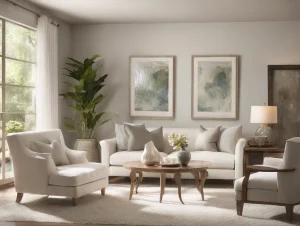As an interior designer with over a decade of experience, I’ve had the pleasure of transforming countless homes into havens of beauty and functionality. One design trend that has remained timeless and universally appealing is the Scandinavian style. Known for its simplicity, minimalism, and functionality, Scandinavian design can turn any space into a serene and chic retreat. In this article, I’ll guide you through the steps to achieve a chic Scandinavian look at home, sharing my passion for creating beautiful, functional spaces through detailed and vivid descriptions.
Understanding Scandinavian Design
Before diving into the specifics, it’s important to understand the essence of Scandinavian design. Originating from the Nordic countries, this design philosophy emphasizes simplicity, clean lines, and a connection to nature. The goal is to create spaces that are both beautiful and functional, with a focus on light and airy environments. The color palette is typically neutral, with whites, grays, and earthy tones dominating. Natural materials like wood, leather, and wool are also key components.
Step 1: Embrace Minimalism
The foundation of Scandinavian design is minimalism. This doesn’t mean your home should be devoid of personality or warmth, but rather that every piece should serve a purpose and contribute to the overall aesthetic. Start by decluttering your space. Remove any unnecessary items and keep only those that are functional and beautiful.
Imagine walking into a living room where every item has its place and purpose. A sleek, low-profile sofa in a soft gray fabric sits against a white wall, adorned with a few carefully chosen throw pillows in muted colors. A simple wooden coffee table with clean lines holds a single vase of fresh flowers. The room feels open, airy, and inviting.
Step 2: Choose a Neutral Color Palette
Scandinavian interiors are known for their light and neutral color palettes. Whites, grays, and beiges dominate, creating a calm and serene atmosphere. These colors also help to maximize natural light, making spaces feel larger and more open.
To achieve this look, start with the walls. A crisp white or light gray paint will set the perfect backdrop. For furniture and decor, stick to neutral tones but don’t be afraid to add subtle pops of color through accessories like cushions, rugs, or artwork. Think of a cozy bedroom with white walls, a light gray bedspread, and soft beige curtains. A single blush pink throw adds a touch of warmth and personality without overwhelming the space.
Step 3: Incorporate Natural Materials
Nature plays a significant role in Scandinavian design. Wood, leather, wool, and linen are commonly used to add warmth and texture to a space. These materials not only create a connection to the natural world but also bring a sense of coziness and comfort.
Consider a dining room with a solid oak table surrounded by sleek, white chairs. A woolen rug in a soft, neutral hue lies beneath, adding texture and warmth. On the table, a linen runner and a few ceramic bowls filled with fresh fruit create a simple yet elegant centerpiece. The combination of natural materials creates a harmonious and inviting environment.
Step 4: Focus on Functionality
Functionality is at the heart of Scandinavian design. Every piece of furniture and decor should serve a purpose and contribute to the overall usability of the space. This doesn’t mean sacrificing style; rather, it’s about finding a balance between form and function.
In a Scandinavian-inspired kitchen, you’ll find sleek, handle-less cabinets in a matte finish, providing ample storage while maintaining a clean and uncluttered look. Open shelving displays everyday items like plates and glasses, making them easily accessible. A multifunctional island serves as both a prep area and a casual dining spot. The layout is efficient and practical, yet stylish and inviting.
Step 5: Let in Natural Light
Natural light is a crucial element in Scandinavian design. The long, dark winters in Nordic countries have led to a design philosophy that maximizes light in every possible way. Large windows, light colors, and strategically placed mirrors all help to create bright and airy spaces.
To make the most of natural light in your home, keep window treatments minimal. Opt for sheer curtains that allow light to filter through while providing some privacy. Place mirrors opposite windows to reflect light and make the room feel larger. Imagine a sunlit living room with floor-to-ceiling windows, sheer white curtains gently swaying in the breeze. A large mirror on the opposite wall reflects the light, further brightening the space and creating a sense of openness.
Step 6: Add Cozy Textiles
While Scandinavian design is often associated with minimalism, it doesn’t mean sacrificing comfort. Cozy textiles like wool throws, sheepskin rugs, and soft cushions add warmth and texture to a space, making it feel inviting and lived-in.
Picture a reading nook with a comfortable armchair in a light gray fabric, draped with a soft, chunky knit throw. A sheepskin rug lies on the floor, providing a plush and cozy spot to rest your feet. A small side table holds a stack of books and a steaming cup of tea. This blend of simplicity and comfort is quintessentially Scandinavian.
Step 7: Incorporate Greenery
Plants are an excellent way to bring a touch of nature indoors and add a pop of color to a neutral space. They also help to purify the air and create a sense of calm and tranquility.
In a Scandinavian-inspired home office, a simple white desk sits against a light gray wall. A few potted plants are strategically placed on the desk and shelves, bringing life and vibrancy to the space. A trailing ivy cascades down from a high shelf, while a fiddle leaf fig stands tall in the corner. The greenery not only adds visual interest but also creates a refreshing and energizing environment.
Step 8: Embrace Clean Lines and Simple Shapes
Scandinavian design is characterized by clean lines and simple shapes. Furniture and decor should have a streamlined and uncluttered look, with an emphasis on functionality and practicality.
Imagine a Scandinavian-inspired bathroom with a sleek, white vanity and a simple, rectangular mirror. The clean lines of the vanity are complemented by the smooth, rounded edges of the sink and faucet. A few carefully chosen accessories, like a wooden soap dish and a glass jar of cotton balls, add a touch of warmth and texture without overwhelming the space.
Step 9: Add Personal Touches
While Scandinavian design is often associated with minimalism, it’s important to add personal touches that reflect your individual style and personality. This can be achieved through artwork, photographs, and meaningful objects.
Consider a Scandinavian-inspired living room with a gallery wall of black-and-white photographs in simple, white frames. Each photo tells a story and adds a personal touch to the space. A collection of ceramic vases on a shelf holds sentimental value, while a woven wall hanging adds texture and interest. These personal touches make the space uniquely yours while maintaining the clean and uncluttered aesthetic.
Step 10: Invest in Quality
Finally, one of the key principles of Scandinavian design is to invest in quality over quantity. Choose well-made, timeless pieces that will stand the test of time and bring lasting beauty to your home.
In a Scandinavian-inspired bedroom, a solid wood bed frame in a natural finish takes center stage. High-quality linens in soft, neutral tones create a luxurious and inviting sleeping environment. A few carefully chosen accessories, like a pair of ceramic bedside lamps and a woolen throw, complete the look. The focus on quality and craftsmanship ensures that the space will remain beautiful and functional for years to come.
Conclusion
Achieving a chic Scandinavian look at home is about embracing simplicity, functionality, and a connection to nature. By following these steps and incorporating the key elements of Scandinavian design, you can create a space that is both beautiful and practical. Remember to focus on minimalism, choose a neutral color palette, incorporate natural materials, and add personal touches that reflect your individual style. With a little creativity and attention to detail, you can transform your home into a serene and chic retreat that embodies the timeless appeal of Scandinavian design.








